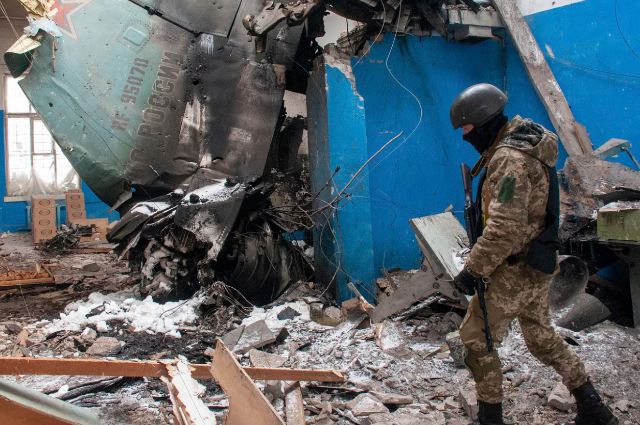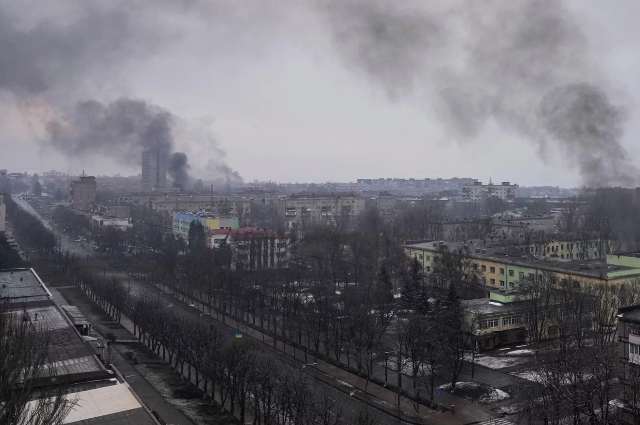From the stone age to the verge of the 22nd century, one thing that is constant is war. The hand of humanity is always covered with the bloodshed of humans themselves. Since the global pandemic, Covid-19, broke out, the whole world is suffering from its core of survival to sustainable development. Now in the first half of the new year 2022, the Russian invasion of Ukraine gave birth to another war pandemic. It is considered as the 3rd world war, after which geopolitics were shaken. Among 44 countries, Ukraine is the second-largest country by area after Russia and surrounded by 7 neighbours, following Belarus to the north, Russia to the east, south of the Sea of Azov and the black sea, Moldova and Romania to the southwest, and a trio of Hungary, Slovakia, and Poland to the west. The country is the home of the largest nuclear plant, “Zaporizhzhia Nuclear Power Plant” with fossil fuel subsidies of around US$2.2 billion reported in 2019. Located in the eastern part of the continent, the major energy sources are the coal and gas industries, and subsequently, the nuclear and oil sectors. If we go deep in history, the struggle for the independence of Ukraine is very long and apparently changes over time.
On 24th February 2022, the Russian president ordered a full-fledged military invasion of Ukraine. By the end of December 2021, more than one hundred thousand Russian troops were near the Russia-Ukraine border that has now successfully entered the residential area of the country, causing hundreds of deaths of civilians as well as soldiers. Many citizens migrated to neighbouring countries to save their lives. A number of refugee camps were established near the border area of Ukraine to serve people who managed to escape from the war zone. The major conflicts between countries are land pieces with natural resources over raw material, water, and biodiversity. But the irony here is by safeguarding resources unknowingly causes the most damage to them. Yes, I am talking about the “environment.” Ukraine occupies 6% of the area in Europe, with 35% of the continent's biodiversity. The aftermath of the war caused damage to the ecosystem across northern Europe and Russia. The Russian military invaded Ukraine, which escalated the environmental to the country’s resources, livelihood, sustainability, and heavy industrial harm. Urban areas like Kyiv, Kharkiv, and Mariupol, became battlegrounds because of heavy fire from Russian planes and artillery. The weapons cause long-term air and water pollution with loss of resources. The tanks, missiles, shelling swallow up the entire environment of residential areas as explosions of pipelines, cables and roads occur in large amounts. Particulate matter smaller than 2. 5 micrometres is harmful to the lungs because it passes down into the bloodstream. These foreign bodies generally include toxic lead and mercury. The air inhaled by both sides, soldiers from both sides and civilians cause lung damage rapidly. Detroit’s immunity potential.
As reported, 1,000 people from 75 countries issued an open letter through the Environmental Peacebuilding Association on March 3,2022 to express their solidarity with Ukraine and show their concern over the environmental and humanitarian toll of the war. The letter states that the war threatens the food security and natural resources of people in Ukraine and other countries that rely on its wheat and corn exports. Disruption of energy or industrial facilities in heavy industry has led to great chaos for the government. In 2014, Russia annexed Crimea, which agitated the fighting in the Donbas. The region has been the site of an ecological disaster. It involves mines and toxic leaks from industrial facilities caused by shelling and munitions. Conventional weapons along with nuclear weapons’ cause enough damage, especially in places where they are disposed of through open burning or detonation. Leading to massive CO2 emissions and contributing to climate change. Ukraine is home to multiple industrial sites. Ukraine ranked low on environmental indicators like air quality, biodiversity production, and ecosystem health, according to the Environmental Performance Index. As it is home to multiple industrial areas.
Major environmental components get effected:
- Air Pollution: In the 1987 Montreal Protocol for damaging the ozone layer in Earth’s upper atmosphere. Military activities result in massive manufacturing, testing, and transport of artillery requiring huge amounts of fuel resources as well as being known to produce the bulk of chlorofluorocarbons (CFCs). Releasing harmful fires results in air pollution. Smoke plumes composed of toxic particulate matter spread over civilian areas largely. Guns and ammunition cause heavy metal pollution as they are made of energetic materials. Sites near to them will also be substantial soil and water pollution. The pollution may include residues from firefighting foams. Naval sites have the potential to generate coastal pollution. Burned-out tanks, transportation vehicles, downed aircraft, and other remnants of fighting are also sources of pollution. That can threaten the marine environment. The United Nations Environment Assembly got underway in Nairobi (Kenya's capital) with some world leaders condemning the Russian invasion and raising concerns over the environmental impact of the conflict. Wildfire heat propels the particulate matter from burned vegetation high into the atmosphere and also led to the residue of complex mixtures of synthetic materials, chemicals, and heavy metals. The small particulate matter might travel thousands of miles, the biggest threat to respiratory health.
- Water facilities: Water facilities were damaged in eastern Ukraine due to an invasion by Russia, leaving up to lakhs of people without water. The Donbas region of Ukraine has been facing this problem for eight years. Pipelines (Seversky Donets-Donbas) to the city were damaged because of fighting around Kakhovka hydroelectric power plant on the Dnieper, which has strategic value representing crossing points for rivers. If Ukraine's hydroelectric dams were to rupture, it could cause "disastrous floods”. Ukraine blocked the north Crimean canal after Russia occupied Crimea in 2014, which was used to divert water from the Dnieper River to irrigate cropland and supply chemical industries.” Crimean Titan”-the largest producer of titanium dioxide in Europe saw major environmental incident in 2018. Russian forces took control of the canal. It is reported that pumps are being fixed and the dam cleared.
Heavy Weapons Use:
Russia’s military uses heavy explosive artillery in populated areas and that has had a widespread impact, including Multiple Launch Rocket Systems and Ballistic missile launchers. The intensification of weapons will lead to devastating consequences for people's lives, natural resources, and the infrastructure that serves them. The explosive weapons include toxic lethal chemicals, asbestos, combustion material, and radioactive metals. Residues and debris lead to groundwater pollution. They have become threats to the light industries, the petroleum industry, and gas stations which are close to residential areas.
Hydrocarbons:
Greenhouse gas (GHG) emissions are generated from fighting and have a long-term impact on a large amount of CO2 being generated. Discourage economic hydrocarbons deposits, hike in global oil and gas prices. Sanctions and banning of Russia, which produces 40% gas in Europe, will change the entire scenario at the global level. The EU would have to reduce its self-dependency on Russia and be in a stronger political position with respect to its banning.
Industrial infrastructure:
Ukraine is heavily polluted due to mining, metallurgy, and chemical manufacturing facilities. War enhanced the toxic pollution. Odesa plant might be hit by the Russian army, so warnings are issued to the people near to it, one of the largest plants where ammonia, Urea, and other chemicals are produced. Due to the risk of shutdown, a power cut situation occurred. Cyber operations were also affected along with industrial operations. Reportedly, on 25th February a big blast happened in the Kharkiv Tractor Plant. The thermal power plant caught on fire due to heavy firing and the transformer burned out.
Habitats:
As conflicts long the landscape is damaged heavily. The Russian army invaded through roads and destroyed the network of transportation. Ukrainian army use land mines to prevent amphibious landing. The bio and geodiversity got disturbed and left permanently. Fighting over bridges resulted in disruption of the coastal area and biosphere reserve. In some cases, the areas where displaced people move may go under pressure, such as herders moving their livestock through sensitive ecosystems. Large-scale refugee movements can also create transboundary environmental impacts when neighbouring countries struggle to cope with people's influx and basic needs.
Chernobyl:
In 1986, Chernobyl’s nuclear power plant reactor exploded, releasing 300 times more radiation than the Hiroshima bombing. After the 1921 Russian famine, Chernobyl registered the highest death and a mutation was found which caused cancer. Russia took control of Chernobyl immediately after the invasion. America called the taking of Chernobyl ‘incredibly alarming” as it is a radioactive dust particle site which has been abandoned hundreds of square miles since the incident. Ukraine has a number of nuclear reactors, with nuclear waste facilities, which increase the rate of contamination and mutation, leading to health issues. Ukraine's situation challenges all the global policies related to climate. The Ukrainian authorities said on their official website that,
“Russia’s attack on Ukraine may cause another ecological disaster by moving its military forces to Chernobyl. If Russia continues the war, Chernobyl could happen again in 2022.”
The result of any war or attack is destruction for both sides. Along with humanity, nature is also in danger. The whole world is battling with environmental changes and global warming. This kind of war only worsens the situation. Making policy by sitting in the room will do nothing. Making a policy with implementation and protecting it till the end is the first and foremost duty of us as humans. If we destroy them, then gradually we will also lose our existence, because in the lap of nature our existence is saved.


